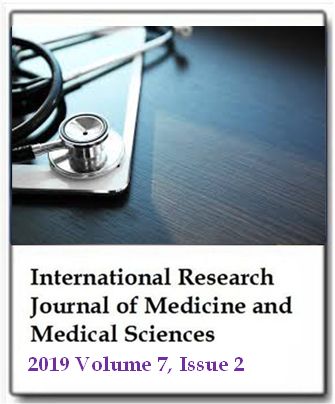Correlation between the shape of the lateral meniscus and risk of extrusion based on MRI of knee joint
Joshi B. and Chaudhary R.International Research Journal of Medicine and Medical Sciences
Published: April 30 2019
Volume 7, Issue 2
Pages 34-39
Abstract
Meniscus extrusion can be considered as a serious and relatively frequent clinical problem and can be also considered as a risk factor for osteoarthritis progression and knee pain symptom. Previous studies have shown a strong association between degenerative radial meniscal tears and extrusion. The aim of this study was to correlate the shape of lateral meniscus and the risk of its extrusion based on MRI examination of the knee joint. A prospective study was done in 75 patients of age group between 18 years and 50 years of age who were referred for MRI of knee joint in a tertiary hospital. The MRI was performed on a Magnetom Amira 1.5 Tesla MRI scanner following TUTH MRI routine protocol of Knee joint. All the cases who met the inclusion criteria were included in the study. After the procedure, images were evaluated. The measurements for the parameters used for this study were done in T1 Coronal image at the level of inter-condylar eminence and Proton density(PD) fat saturated sagittal image at the mid bow tie level where the morphology of the lateral meniscus were clearly delineated. Then the recorded data for each patient was correlated with the extrusion of the lateral meniscus along with body mass index (BMI) of the patient. The study showed a strong positive linear correlation of BMI and lateral meniscus-bone angle [LMBA] with meniscus extrusion, where (r=0.94; p=0.000) and (r=0.857; p=0.000) respectively. However, lateral meniscus-cartilage angle [LMCA] and lateral meniscus-cartilage height [LMCH] showed a moderate positive linear correlation with meniscus extrusion (r=0.564; p=0.000) and (r=0.305; p=0.26) respectively. The height of the anterior and posterior horns of the lateral meniscus showed the mean dimension of about 6.13(SD±0.62) mm and 6.30 (SD±0.58) mm respectively in our study. Similarly, the mean antero-posterior diameter of the anterior and posterior horns of the lateral meniscus were found to be 11.3(SD±1.06) mm and 11.4(SD±1.02) mm, respectively. Finally, the mean meniscus extrusion of the lateral meniscus observed beyond the tibial margin were about 2.57 (SD±0.93) mm whereas, the maximum meniscus extrusion was found to be 4.7 mm. In conclusion, increased BMI and LMBA showed significant increased risk of lateral meniscus extrusion beyond the tibial margin. However, LMCA and LMCH showed statistically moderate relation with the risk of lateral meniscus extrusion.
Keywords: Extrusion, knee joint, meniscus, MRI.
Full Text PDFThis article is published under the terms of the Creative Commons Attribution License 4.0

